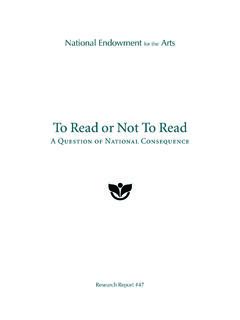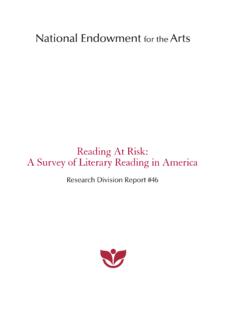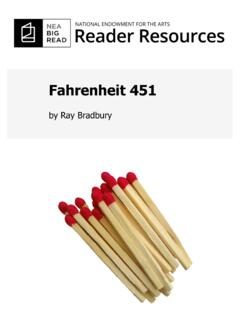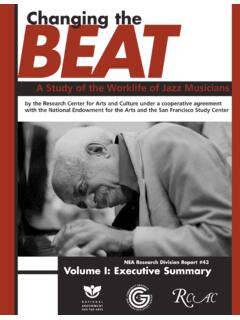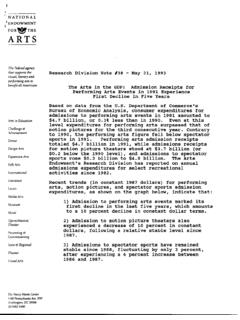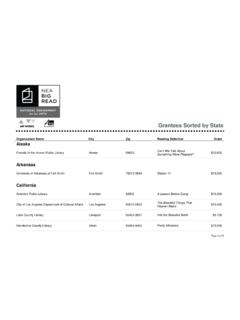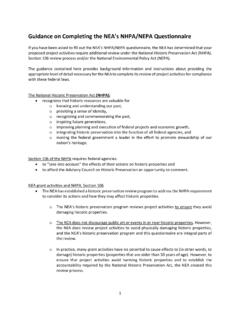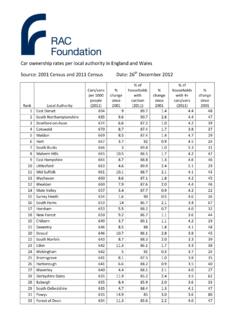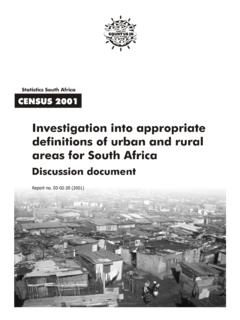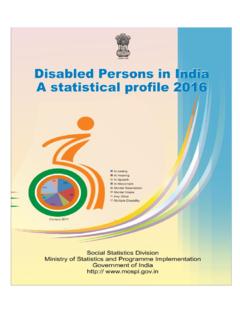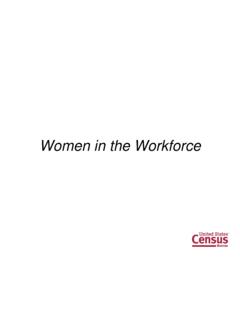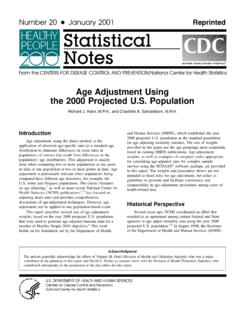Transcription of Artists and Arts Workers in the United States
1 1 Artists and Arts Workers in the United States National Endowment for the Arts NEA Research Note #105 October 2011 Artists and Arts Workers in the United States Findings from the American Community Survey (2005-2009) and the Quarterly census of Employment and Wages (2010) Background The availability of American Community Survey (ACS) data for 2005-2009 allows researchers to produce reliable national estimates of the number, variety, and distribution of Artists in the United States . This Research Note extends the NEA s previous analysis of ACS data for 2003-2005. That report, Artists in the Workforce: 2000-2005, identified key similarities and differences between Artists and other Workers .
2 For example, it revealed the following patterns: Artists are highly entrepreneurial. They are times more likely than the total workforce to be self-employed. Artists are generally more educated than other Workers . Over half of all Artists have received at least a bachelor s degree. Artists are less likely than other Workers to have full-year or full-time employment, which partly accounts for their annual median incomes being lower than those of Workers with similar education levels. Using new data, NEA Research Note #105 confirms and expands those earlier findings. The study mines the ACS for characteristics that were left unexamined by the 2008 report.
3 Among other factors, this Note explores the relationship between individual artist occupations and specific industries; occupational and industry patterns for Artists (and other Workers ) who obtained a college degree in an arts-related subject; and the likelihood of Artists to have changed addresses in the previous year. Through another dataset, the 2010 Quarterly census of Employment and Wages, the NEA Office of Research & Analysis is also able to report the concentration 2 Artists and Arts Workers in the United States of arts employment at the state and metropolitan level. Together, these new variables bring greater depth to our understanding of Artists and arts industries as core components of the total labor force.
4 Introduction For more than three decades, the National Endowment for the Arts has reported on the number, variety, and distribution of Artists in the United States . The NEA s Office of Research & Analysis bases these statistics on nationally representative data from the census Bureau. Formerly, researchers were obliged to wait until each decennial census ( , in 1970, 1980, 1990, and 2000) before they could begin analyzing and reporting facts and figures about the nation s Artists . In 2003, however, the census Bureau launched the annual American Community Survey (ACS), which was designed to replace the decennial census long-form questions about employment.
5 With the advent of this survey, researchers had the ability to produce reliable yearly estimates of Artists and other Workers . Yet this resource could not be tapped immediately. Since 2003, ACS public-use data files have lacked adequate sample sizes for a thorough analysis of Artists , which compose percent of the total workforce. In 2008, therefore, the NEA merged data files from 2003 through 2005 to obtain estimates comparable to those from the 2000 decennial census . Findings of that study appeared in Artists in the Workforce: 1990 to 2005. The report showed that from 1990 to 2005, Artists had grown at the same rate as the overall labor force, after a 20-year surge that surpassed the growth rate of other Workers .
6 The report also found that Artists are highly entrepreneurial they are times more likely to be self-employed and they have generally higher levels of education than most other Workers . (Both findings have been confirmed by the present study.) On the other hand, far fewer Artists work full-time or full-year, compared with other Workers ; and though they qualify as professional Workers , according to census nomenclature, they still earn far less than other Workers in this category. Finally, the 2008 report showed where Artists are likely to cluster, by geographic region, state, and metropolitan area.
7 With the publication of this Research Note (#105), the American Community Survey has amassed four additional years of data about Artists . Compiling multi-year averages from the ACS public-use data for 2005 through 2009, the NEA s Office of Research & Analysis now can extend the terrain mapped by the 2008 report. 3 Artists and Arts Workers in the United States Before proceeding, one should acknowledge some limitations of this analysis. First, while a revision to the ACS questionnaire has led to more accurate measures of the artist workforce, the change limits its comparability of 2005-2009 estimates with those from the 2000 decennial To ascertain trends in the size of the artist labor force, therefore, this Note draws on the Current Population Survey, a monthly household survey sponsored by the Bureau of Labor Second, with few exceptions, this report does not present data about individual artist occupations at the state level.
8 The ACS estimates shown here stem from the 2005-2009 public file a sample of approximately 67 percent of the ACS respondents in those years. Although roughly 15 million people are represented in this public file, sample sizes are still too small to yield accurate estimates of Artists in certain occupations ( , actors) in small-population States . As a result, for the majority of the state comparisons in this Note, Artists are considered as a group, irrespective of the distinct occupations of which they are comprised. The NEA s Office of Research & Analysis plans to report detailed artist occupation estimates for States and metropolitan areas in 2012 or 2013, following the release of the census Bureau s EEO Tables, which will draw on the full ACS to provide detailed occupational data for States and metropolitan areas.
9 As with the NEA s previous research reports on Artists in the workforce, this Note examines 11 distinct artist occupations, separately and together (see text box, ): Actors Announcers Architects Dancers and choreographers Designers Fine Artists , art directors, and animators Musicians Other entertainers Photographers Producers and directors Writers and authors 4 Artists and Arts Workers in the United States To be counted as an artist, survey respondents must have identified a job within one of these 11 occupational categories as accounting for the most number of hours worked in a given week.
10 In other words, being an artist is their primary job. A separate data source, the Current Population Survey, reveals that in 2010 roughly 264,000 Workers had a secondary job as an artist that is, they worked most of their weekly hours in another This Research Note groups key findings into four topic areas: 1) the number of Artists and the distribution of specific artist occupations; 2) Artists socioeconomic and demographic traits; 3) Artists working patterns, including industry affiliations, sector employment, and undergraduate training; and 4) concentration of Artists and arts Workers at the state and/or metropolitan level.
